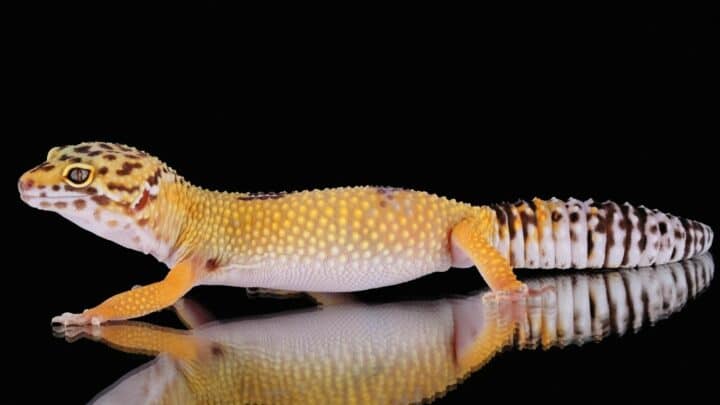Leopard geckos are incredibly forgiving of their caregivers. They rarely complain or come down with sickness if their diet and environment aren’t perfect.
They are hardy little reptiles that are a complete joy to own.
Of course, even the hardiest of little reptiles has the occasional medical issue, and leopard geckos aren’t exempt from that fact.
The good news is that when your leopard gecko changes color, such as black or purple splotches appearing on its belly, it’s typically not a sign of anything too serious.
What Could Be The Reason For A Black And Purple Leopard Gecko Belly?
Leopard geckos usually turn colors, such as black and purple, if it’s feeling more stressed than usual, has stuck skin from shedding, the enclosure has a temperature imbalance, or it’s constipated. Though they aren’t life-threatening, approach them right away.
Explaining A Discolored Leopard Gecko Belly
While it’s best to see your vet as soon as you notice a problem, there are a few not-too-serious reasons that leopard gecko bellies turn blackish purple.
Before you panic, take a moment to read through it and see if any of these causes apply to your gecko, and then call your vet and make an appointment for verification.
Shedding
Adult leopard geckos shed quite often, once every 4-6 weeks. When it’s time for your gecko to shed, make sure you keep an eye on any color changes, as it may indicate stuck skin.
Stuck skin means a piece of skin has trouble breaking loose during the shedding process, and it has tightened to cut off proper blood supply to a part of the body.
Stuck skin often happens around the leg and toe area (hence the toes turning blackish purple), but it’s not unheard of for it to happen around the belly.
Since leopard geckos like drier environments, shedding entirely can be difficult for them.
You can prevent skin from getting stuck by providing a moist hide for your gecko to lay in, as the moisture will help it successfully shed the skin.
You can also help them along by soaking them in a warm bath, but your best bet is to ask your vet for assistance.
Stress or Environmental Imbalance
Take note if there’s been a change in the environment, such as fluctuating temperatures or intense humidity, your leopard gecko may become stressed.
Notice if it’s too loud around its tank or if there is an imbalance between the night and daytime hours.
Leopard geckos need darkness. It’s when they prefer to move around their enclosure and eat.
Providing too much light can definitely cause stress in a leopard gecko. It’s essential to eliminate other reasons for a black and purple tummy before pinpointing stress as the culprit.
Impaction
Leopard geckos are relatively small, and because of this, they have a small digestive system.
Their food moves through them rather quickly, and it’s crucial to ensure that the blackish purple spots forming on the belly aren’t from constipation or impaction.
You should bring your leopard gecko to the vet to ensure that impaction isn’t a problem because it’s potentially life-threatening. If you’ve noticed your gecko isn’t hungry, constipation could be the offender.
Warm baths and massages to the affected area are helpful in the case of constipation, but it’s best when left to a professional.
As owners, we always want to do what’s best for our leopard geckos, and consulting the vet is what’s best.
Worrying about your leopard gecko is not fun. Watching their bellies turn color is stressful for you, so choosing to get to the bottom of it right away is the best direction to take.
Discoloration, while rarely fatal, is always a cause for concern. Anything out of the ordinary is our little lizard trying to tell us that something isn’t right with them and to take a closer look!
Frequently Asked Questions about What Could Be The Reason for a Black and Purple Leopard Gecko Belly
Why does my leopard gecko have a blackish-purple belly?
Your leopard gecko likely has a blackish-purple belly due to intestinal impaction, stress, environmental changes, temperature imbalance, or a shedding issue. The potential problems vary greatly, so it’s essential to see a vet.
Is my leopard gecko dying?
If the only symptom is a blackish-purple-colored belly, it’s not likely that your leopard gecko is dying. Leopard geckos tend to lose substantial weight, become lethargic, and stop showing interest in food when they’re dying. Check with your veterinarian, but your gecko will very likely be fine.
How quickly will my leopard gecko recover?
It depends on the actual problem, but your leopard gecko will likely recover quickly from any issue causing stomach discoloration. While it’s essential to address the problem right away, spending time worrying about your leopard gecko dying or not recovering fully is likely a waste of time.
Reptiles and Discoloration
Discoloration, mainly due to shedding, is not uncommon for reptiles to experience. Still, you should have your veterinarian address it as soon as it’s noticed to prevent the issue from spiraling out of control.
More often than not, the discoloration can be easily and quickly addressed and rarely indicates a serious problem unless accompanied by other symptoms.
Overall, leopard geckos are hardy, and that includes the ability to recover well.


